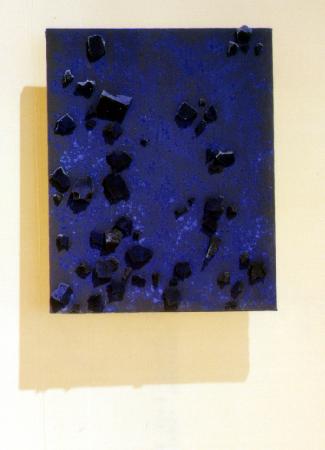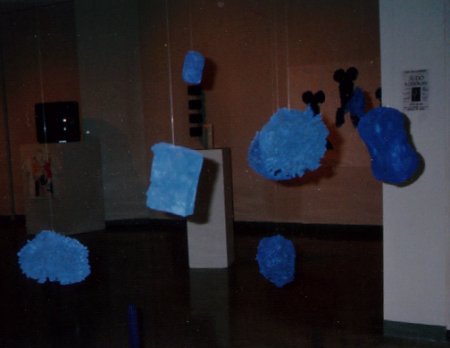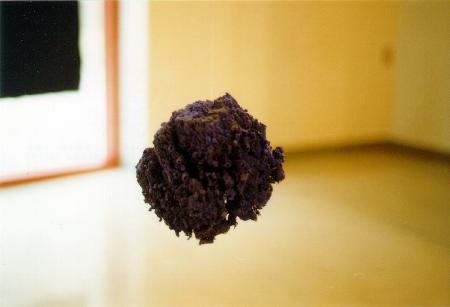| Back to show catalogue | ||
|
KlienŪs Blue Air Sculptures - Melissa Jeaurond  When Yves Klein decided to create air sculptures, his main concerns were
surrounding the representation and illusion of space and immateriality.
He wanted to convey the notion of weightlessness. His main struggle was
with trying to free the sculpture form the pedestal, but gravity forced
the sculpture to remain grounded to the earth. When faced with the question
of what is art's relationship to space Klein said "We will know the force
of attraction toward the high realms, toward space, toward nowhere and
everywhere both at once. The force of terrestrial attraction thus mastered,
we will literally levitate in total physical and spiritual freedom." (Stich
p.159). He believed that once we mastered what we were meant to achieve
while on earth, then we could ascend to a higher level and float off into
space. Before Klein created La foret d'eponge (1957-61)
as a conductor for hi thoughts on immateriality and space, be created other
forms of air sculptures. In one of his projects he wanted to make an air
sculpture out of an aluminum tube (which he wanted to somehow fill with
helium so it could become a "flying or levitating" sculpture). For this
project, he fantasized about having žclearÓ air flowing through one side
of the sculpture, and blue air coming out on the other side of the work.
The proposal never took on a material shape, but the concept still exists
as a drawing.
When Yves Klein decided to create air sculptures, his main concerns were
surrounding the representation and illusion of space and immateriality.
He wanted to convey the notion of weightlessness. His main struggle was
with trying to free the sculpture form the pedestal, but gravity forced
the sculpture to remain grounded to the earth. When faced with the question
of what is art's relationship to space Klein said "We will know the force
of attraction toward the high realms, toward space, toward nowhere and
everywhere both at once. The force of terrestrial attraction thus mastered,
we will literally levitate in total physical and spiritual freedom." (Stich
p.159). He believed that once we mastered what we were meant to achieve
while on earth, then we could ascend to a higher level and float off into
space. Before Klein created La foret d'eponge (1957-61)
as a conductor for hi thoughts on immateriality and space, be created other
forms of air sculptures. In one of his projects he wanted to make an air
sculpture out of an aluminum tube (which he wanted to somehow fill with
helium so it could become a "flying or levitating" sculpture). For this
project, he fantasized about having žclearÓ air flowing through one side
of the sculpture, and blue air coming out on the other side of the work.
The proposal never took on a material shape, but the concept still exists
as a drawing.
He also created an air sculpture out of one thousand and one helium filled
blue balloons,
To create the sponge sculptures, he would place one sponge, or a cluster of sponges, on top of a metal rod which was žaffixed to stone bases or metal plates or grounded by twisting the rod itself into a footing÷ The rods were diversely tall & short, curving & straight; & the bases ranged from giant or small rooks with craggy or smooth surfaces to flat, shiny, or swirling footings." (Stich, p.161). Since no sponge sculpture was ever really the same, the gallery space was filled with an assortment of things which resembled flowers, trees, strange vegetation, and even human figures (Klein often referred to his sponge sculptures as "portraitsÓ)
The forest of sponges is meant to imply that ža process of natural growth
and proliferation was taking place" (Stich, p.165), that these blue trees
and flowers were natural growth In a small area which were evolving and
multiplying as Klein continued to create hundreds of blue Standing sculptures
and žunattachedÓ blue sponges. The forest was meant to emphasize an allusion
to nature, and reference the differences which can be found within a seemingly
similar object. He was interested in the diversity which occurred
in multiplicity. Along with these mentioned standing sponge projects, Klein
created sponge relief paintings (a blue monochrome painting with blue sponges
attached to the surface). These painting were exhibited with the standing
and attached sponge sculptures, adding to the diverse appearance of each
sponge.
His sponge air sculptures are a natural progression in Klein's work as
he searched for a form of freedom from weightiness, a defiance of gravity.
It is an obvious concept which reappears through out his career in such
works as The Void (1958, where the viewer enters an empty room and is surrounded
by nothingness, by empty space), and Leap into the Void (1960, appearing
in Dimanche with the caption žUn Homme dans l'espace! Le peintre
de l'espace se jette dans le vide!÷.Obsession de la levitation.Ó (Stich,
p.216). He also made a work where he signed the sky with his name,
in a sense making him become vicariously weightless and in the sky since
he is identified and recognized as being Yves Klein. The theme of
levitating into open space is unmistakably a reoccurring, driving passion
behind most of the works created by Yves Klein.
|
||
 Still not satisfied that he had captured the thoughts and concepts of the
air sculpture, the idea of the sponge sculptures emerged, and Klein reconceptualized
the air sculptures into žaerostatic objects". He made hundreds of blue
sponge sculptures of varying heights, shapes, sizes and textures, which
were put on display on June 15,1959, at the Galerie Iris Clert. He
displayed the sculptures on the back and side areas of a small room, žtransforming
the gallery into a lush, crowded, sylvan environment.Ó (Stich, p.161).
This project was meant to allude to the beauty and overgrowth of a natural
woodland area.
Still not satisfied that he had captured the thoughts and concepts of the
air sculpture, the idea of the sponge sculptures emerged, and Klein reconceptualized
the air sculptures into žaerostatic objects". He made hundreds of blue
sponge sculptures of varying heights, shapes, sizes and textures, which
were put on display on June 15,1959, at the Galerie Iris Clert. He
displayed the sculptures on the back and side areas of a small room, žtransforming
the gallery into a lush, crowded, sylvan environment.Ó (Stich, p.161).
This project was meant to allude to the beauty and overgrowth of a natural
woodland area.
 Since sponges were naturally absorbent, they were the perfect materials
to use to provide Klein with žthe kind of saturation he sought to achieve:
Saturation of both the environment and the peopleÓ (Stich, p. 165).
He saw his sponge projects as perfect examples of successful žimpregnation
process [which] held their own as suggestive, indefinable, ambient, penetrative
phenomenaÓ (Stich, p. 165). Klein wanted his audience to fell that
art was still connected to the experience of real life, explaining his
desires to create sculptures which reference the natural world. He
hoped to offer a piece of freedom, of weightlessness, served along side
a slice of reality, thus making the audience feel weightless, yet grounded,
just like the sponge sculptures which were trying to brake free and float
into space.
Since sponges were naturally absorbent, they were the perfect materials
to use to provide Klein with žthe kind of saturation he sought to achieve:
Saturation of both the environment and the peopleÓ (Stich, p. 165).
He saw his sponge projects as perfect examples of successful žimpregnation
process [which] held their own as suggestive, indefinable, ambient, penetrative
phenomenaÓ (Stich, p. 165). Klein wanted his audience to fell that
art was still connected to the experience of real life, explaining his
desires to create sculptures which reference the natural world. He
hoped to offer a piece of freedom, of weightlessness, served along side
a slice of reality, thus making the audience feel weightless, yet grounded,
just like the sponge sculptures which were trying to brake free and float
into space.